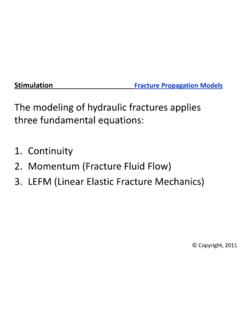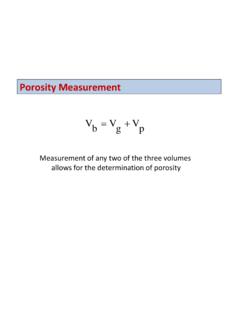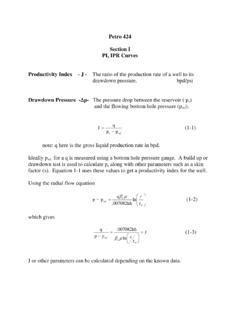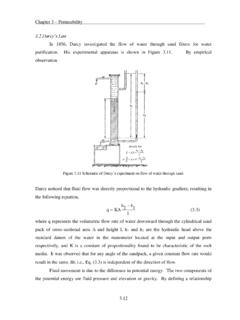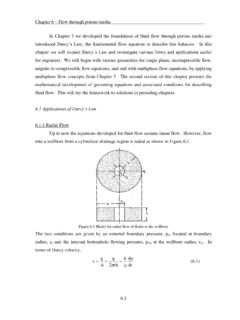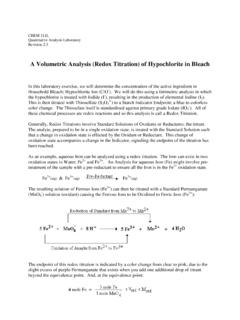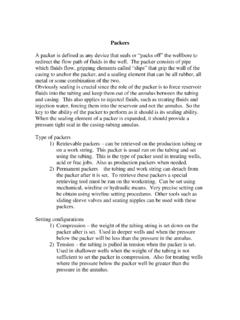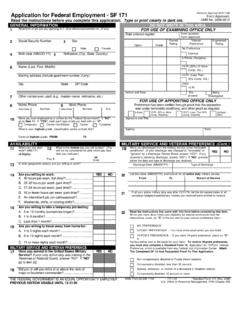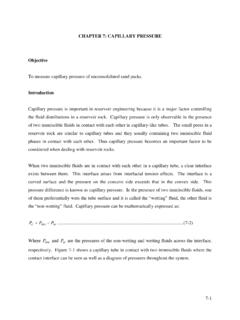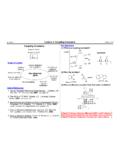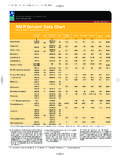Transcription of Determination of Equilibrium Constants using …
1 CHEM 331L Physical Chemistry Laboratory Revision Determination of Equilibrium Constants using NMR spectroscopy In this laboratory exercise we will measure the Equilibrium constant for the cis-trans isomerism about a peptide bond involving the amino acid L-Proline. This will be accomplished by determining the relative concentrations of each isomer using key proton signals in a Nuclear Magnetic Resonance (NMR) spectrum of a solution of an N-Acetyl derivative of the amino acid, which will serve as a model for peptide bonds involving Proline. In each case, the relative concentration of the Equilibrium species can be determined from the NMR signal strength. The relative concentrations can then be leveraged to determine the desired Equilibrium constant . This data can then be used to determine for the isomerization reaction. We will consider the Equilibrium in both polar and non-polar solvents as well as in aqueous solutions of various pH's.
2 In general, we write the Equilibrium constant Kc for a chemical reaction: a A + b B c C + d D as: Kc = (Eq. 1) Recall, each concentration [i] is the Equilibrium concentration of species i relative to the standard concentration of 1 M. Thus, Kc is unit-less. Once Kc has been determined, the Standard Gibbs Free Energy change for the reaction can be calculated according to: Go(T) = - RT ln Kc (Eq. 2) Naturally occurring -amino acids are the monomeric building blocks of proteins and small peptides and bond together via a peptide linkage. Because the peptide bond has a resonance form that exhibits significant C=N double bond character, rotation about this bond is typically restricted. P a g e | 2 This means the peptide bond can exist in both cis and trans isomeric forms: The Equilibrium constant for the isomerization reaction can be written as: Ktrans = [trans] / [cis] (Eq.)
3 5) Biologically, generally the trans isomer dominates because of the energetically unfavorable interaction between the R side-chains in the cis isomer; the cis configuration being ~ 8 kJ/mol less stable than the trans. Biochemistry, 2nd Ed. Donald Voet and Judith G. Voet However, Proline residues are special because the side-chain consists of a pyrrolidine ring which includes the -amine of the amino acid. L-Proline For this reason, both the cis and trans isomers of peptide bonds involving Proline followed by another amino acid residue are roughly equivalent energetically. P a g e | 3 And, roughly 10% of peptide bonds in naturally occurring proteins involving Proline occur in the cis configuration. In this configuration Proline acts to induce hairpin turns in the proteins's secondary structure. This is illustrated by the case of the secondary structure of the protein Ribonuclease S.
4 Hairpin in Ribonuclease S Biochemistry, 4th Ed. Lubert Stryer As noted by Stryer, "Prolyl [or Proline-Amino Acid peptide bond] isomerization is the rate-limiting step in the folding of many proteins in vitro. Spontaneous isomerization is slow because the bond between the carbonyl carbon and the amide nitrogen has partial double bond character. Peptidyl prolyl isomerases (PPIases) accelerate cis-trans isomerization more than 300 fold by twisting the peptide bond so that the C, O, and N atoms are no longer planar." Additionally, it is commonly found that Proline residues initiate or terminate -helical protein segments.. [rotations of residue i] within a polypeptide chain are [generally] independent of rotations within neighbors i-1 and i+1. However, in the case of the succeeding residue (i+1), it matters whether or not the (i+1)th residue is proline; the usual interactions of the ith residue with the amide hydrogen of the (i+1)th are replaced by steric conflicts involving the atoms of the pyrrolidine ring, particularly the -CH2- group attached to the imide nitrogen.
5 Therefore, the rotational freedom of a residue succeeded by proline may be expected to be more restricted than if it preceded one of the other residues.. a proline can occur at the beginning of an -helical sequence, but it prevents the preceding residue from adopting the helical conformation if that residue is not glycine. Thus, the fact that the proline nitrogen cannot participate in a hydrogen bond is not the primary cause for the ability of this residue P a g e | 4 to disrupt -helical sequences, although this reason is often given as the basis for proline's helix-disrupting tendencies. Biophysical Chemistry Part I: The Conformation of Biological Macromolecules Charles R. Cantor and Paul R. Schimmel We will use N-acetyl-L-proline as a model for peptide bonds involving Proline. We will measure the Equilibrium constant for the cis-trans isomerism of this compound and treat this constant as being representative of Proline involved peptide bonds with other amino acids.
6 N-Acetyl-L-Proline (trans Configuration) The NMR signals of the and protons of N-acetyl-L-Proline are sensitive to its cis-trans isomerization. The relative strengths of the NMR signals will be proportional to the concentration of each different form. Thus, the Equilibrium constant for the cis-trans isomerization reaction can be determined by measuring the integrated NMR signals from and protons of each form. In non-aqueous environments, it is expected that the carboxyl hydrogen of this molecule can form an intramolecular hydrogen bond with the peptide carbonyl when the peptide bond is in the trans conformation, thus stabilizing the trans isomer. N-Acetyl-L-Proline (trans Configuration - Intramolecularly H-Bonded) The H-bond also partially "neutralizes" the dipole moment of the carbonyl group C=O , increasing its affinity for a non-polar environment.
7 Thus, it is expected that the trans isomer will be increasing favored as the polarity of the solvent decreases. To illustrate this effect, we will measure the cis-trans Equilibrium constant in two non-aqueous environments; Acetone ( = 21) and a 45:55 Benzene ( = ):Chloroform ( = ) mixture. P a g e | 5 (Recall, the dielectric constant is a rough measure of the polarity of a liquid.) In the former case the solvent is relatively polar, whereas in the latter, the solvent is non-polar. Finally, we will measure the Equilibrium constant in aqueous solutions of lower and higher pH. The carboxyl Hydrogen is ionizable. This is important because the cis configuration is slightly more acidic (pKa ~ ) than the trans form (pKa ~ ) and when ionized the trans form has two negatively charged Oxygens, one being the Oxygen of the peptide carbonyl C=O and the other being the deprotonated carboxylate, in proximity to each other.
8 This serves to destabilize the trans isomer and shifts the Equilibrium toward the cis isomer. We should observe this deprotonization effect at higher pH's. N-Acetyl-L-Proline (trans Configuration - Deprotonated) NMR Spectra in General The proton at the heart of the Hydrogen atom, like the electron, exhibits behavior reminiscent of a spinning top. And, like the electron, its spin is quantized; limited to the states of Up and Down . In the presence of a strong external magnetic field (Ho), the energy of the two spin states splits; the stronger the field the greater the splitting. A photon whose frequency is such that its energy matches the energy difference between the spin states can be absorbed: E = Ephoton = hc / In NMR spectroscopy , these photons will lie in the Radio Frequency region of the electromagnetic spectrum. P a g e | 6 Now, this would be rather uninteresting if all the Hydrogen atoms in a molecule had nuclei that absorbed at exactly the same frequency.
9 We would observe a single absorbance peak. However, locally, each Hydrogen atom is in a different environment. These environmental differences will lead to slight differences in the magnetic field experienced by the proton and will cause the splitting to vary slightly. This will lead to differences in the frequency of the absorbed photons. For instance, protons near the exterior of a Benzene ring experience a deshielding due to a locally induced magnetic field arising from the circulation of the electrons. This causes the spin state splitting to increase and shifts the absorbance frequency. This Chemical shift effect is measured in machine independent units of . The chemical shift is highly correlated with molecular structure and will provide us with an important clue as to the environment in which each proton finds itself. Finally, neighboring protons can influence the environment of each other via a mechanism called spin-spin coupling.
10 Consider two neighboring protons A and B. A will observe that B can occupy its two possible spin states. Whether B is spin Up or Down will influence the spin states of A; the coupling is through the chemical bonds connecting the Hydrogen atoms. One case will cause A to absorb at a slightly higher frequency and the other a slightly lower frequency. This will lead to a splitting of A s absorbance into a doublet . If A couples to two Hydrogen atoms, then the splitting will occur again and a triplet will be observed; etc. As an example, the molecule CH3CH2Cl should exhibit two NMR signals. The first is due to the CH3- protons and will be split into a triplet due to the neighboring two protons. The other signal, P a g e | 7 due to the -CH2- protons, should be split into a quartet. As seen in the spectrum below, this is in fact the case: Introduction to Organic Chemistry, 2nd Ed.
